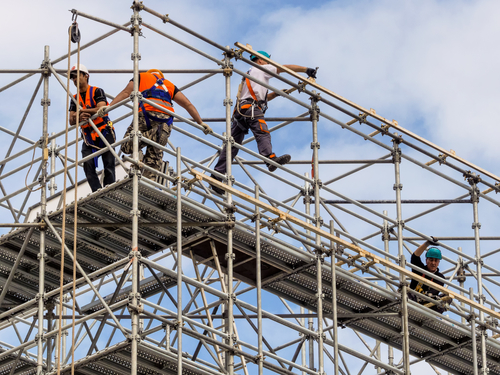Construction is a necessary industry, but it’s also one of the most dangerous. In 2022, there were 11 construction site fatalities reported in New York City. Nine of those deaths were falls. 200 other people were reported injured.
Even though not every fall is fatal, you could be facing a lengthy recovery or might be unable to work. Scaffolding work is risky and requires taking into account several safety regulations. Employers need to have valid permits and offer their workers the tools they need to work in safe conditions.
Learn more about scaffold safety and how to protect yourself on the job.
New York’s Scaffold Law
All worksites must adhere to Occupational Safety and Health Administration and federal regulations. Contractors in New York must follow New York Labor Law 240. It states that contractors must take precautions to properly install scaffolding and other equipment related to working at considerable heights.
That means anyone installing scaffolding and related equipment will properly protect anyone working on the site. The general contractor and owner of the job site are liable if a worker falls or is injured by the scaffolding, according to this labor law.
Injuries In Scaffolding Accidents
Falling from a great height can be devastating. Many aspects of the accident will determine how severe the injuries can be. Factors like how high the fall is, the surface the victim lands on, or if other objects are falling can all affect injuries.
Victims injured in a scaffolding accident could suffer from:
- Traumatic brain injuries
- Skull fractures, concussions, or other head injuries
- Spinal cord injuries
- Neck and back trauma
- Knee injuries
- Should injuries
- Broken or fractured bones
- Bruises, cuts, or abrasions
Getting Compensation After a Scaffolding Injury
Most construction jobs will offer workers’ compensation benefits, which are designed to pay for accidents caused on a job site. In many cases, you might be able to pursue a third-party liability claim to pursue full reimbursement for your damages.
Workers’ comp benefits can provide financial relief for your medical expenses related to your work injury. Your third-party claim allows you to pursue compensation for your related economic and non-economic damages.
Economic damages are out-of-pocket expenses, like medical bills or property damage, you have to pay because of your accident. Non-economic expenses are the conceptual costs related to your economic losses. That includes the pain and suffering your accident caused, or a reduced quality of life due to your injuries.
Who Is Liable in a Scaffolding Injury?
A third-party liability claim can be brought against someone whose negligence caused your injuries. There are many parties who could be responsible for your scaffolding accident.
There are several people who may have contributed to your accident. Negligent parties in a scaffolding accident could include contractors, subcontractors, coworkers, or the property owner.
Protecting Yourself from Scaffolding Accidents
Your employer should offer mandatory training sessions on scaffolding safety. Here are some ways you can proactively protect yourself from accidents.
- Check that the Permits are up to Date: Permits should be timely and legal. If you didn’t put together the structure, verify that someone properly trained did so. Do not work on a scaffold if you don’t understand how it works, or you are not well-trained to resolve a structural difficulty. It’s legally required that all workers using scaffolds be well-trained.
- Structural Requirements: The footing or anchorage for scaffolds must be sound, rigid, and capable of carrying the maximum intended load without displacement. Unstable objects such as barrels, boxes, loose bricks, or concrete blocks should not be used to support scaffolds or planks. An access ladder or equivalent safe access must be provided. The poles, legs, or uprights of scaffolds must be plumb, and securely and rigidly braced to prevent swaying and displacement. The scaffold should also be equipped with safety rails to prevent the worker from falling to the ground.
- General Requirements: Scaffolding should be clean, without grease or other elements that may cause slip and falls, especially on the platforms. The area of the scaffold should be limited with a safety cord to avoid the access of workers below, as there’s a risk of objects falling from above. The law prohibits the use of scaffolding during hazardous weather conditions such as strong winds, storms, snow, or ice.
- Worker’s Safety: It is key that the worker takes the appropriate time to do the work. Working at high altitudes is dangerous and the precautions that should be taken are higher. The worker must be protected by a safety life belt attached to a lifeline. Workers must also use a helmet.
Call a NY Scaffolding Injury Accident Lawyer
Any accident that involves a scaffold could have serious consequences. You might recover quickly, but you should be compensated for any time you’re forced off the job or for any money you have to spend because of someone’s negligence.
The construction accident lawyers at Hecht, Kleeger & Damashek, P.C., have helped clients recover millions after someone else caused them to suffer. We can help you fight for the compensation you deserve. We have decades of experience. We want you to know your rights and legal actions after a construction accident hurts you.
Let us help you. Call (212) 490-5700 or use our contact form to schedule your free consultation. There aren’t any fees unless we win.

